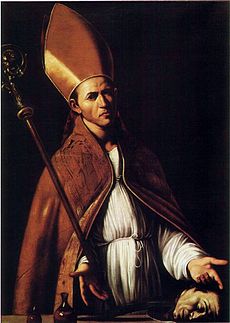- Roman Catholic Archdiocese of Benevento
-
The Italian Catholic archdiocese of Benevento (Latin: Archidioecesis Beneventanus) has a long history; it now has as suffragan dioceses the diocese of Ariano Irpino-Lacedonia, the diocese of Avellino, the diocese of Cerreto Sannita-Telese-Sant'Agata de' Goti, the Territorial Abbey of Montevergine, and the archdiocese of Sant'Angelo dei Lombardi-Conza-Nusco-Bisaccia.[1][2]
Contents
History
The Roman Catholic Diocese of Benevento was founded in the first century. During the persecution of Diocletian we find mentioned a bishop of this city Januarius who together with Proculus his deacon and two laymen was imprisoned and beheaded at Pozzuoli in 305. The see of Benevento was elevated in status to an archdiocese on 26 May 969.[1] The cathedral of Maria SS. Assunta in Cielo was founded in Lombard times, but was destroyed by Allied bombings in World War II; it has kept the medieval Romanesque façade and bell tower, and the 8th century crypt.
Leadership
Bishops
- Januarius I (until 305)
- Theophilus (313)
- Januarius II (343)
- Emilius (405)
- Marcianus (533)
- Barbatus I (602)
- Hildebrand (until 663)
- Barbatus II (663–682)
- Beatus Joannes (684–716)
- Toto (until 743)
- Monoald (743)
- Ursus (830)
- Petrus I (887)
- Joannes I (910–914)
- Joannes II (943–956)
Archbishops
- Landolfo I (956-983)
- Alone (983)
- Alfano I (985-1001)
- Alfano II (1001–1045)
- Maldefrido (1045–1053)
- Ouldarico (1053–1069)
- San Milone (1074–1075)
- Roffredo I (1076–1107)
- Landolfo II (1108–1119)
- Roffredo II (1120–1130)
- Landolfo III (1130–1132)
- Gregorio (1132–1145)
- Roseola (1145–1146)
- Pietro II (1146–1155)
- Enrico (1156–1170)
- Lombardo (1171–1179)
- Ruggiero (1179–1225)
- Ugolino (1225–1254)
- Capoferro (1254–1280)
- Castrocielo (1282–1295)
- Giovanni (1295–1300)
- Adenolfo (1300–1302)
- Giacomo (1302–1303)
- Monaldo (1303–1331)
- Arnaldo (1332–1344)
- Guglielmo (1344–1346)
- Stefano (1346–1350)
- Pietro III (1350–1360)
- Geraud (1360)
- Guillaume (1362)
- Ugone (1363)
- Ugone (1363)
- Francesco (1365–1383)
- Niccolo (1383–1385)
- Donato (1385–1426)
- Paolo (1427–1429)
- Gaspare Colonna (1430–1435)[3]
- Astorgio Agnesi (1436–1451)
- Giacomo Della Ratta (1451–1460)
- Alessio de Cesari (1460–1464)
- Niccolò Piccolomini (1464–1467)
- Corrado Capece (1469–1482)
- Leonardo Grifo (1482–1485)
- Lorenzo Cibo de' Mari (1486–1502)
- Ludovico Podocataro (1503–1504)
- Galeotto (1504–1508)
- Sisto Gara della Rovere (1508–1513)
- Alessandro (1514–1530)
- Francesco della Rovere (1530–1544)
- Giovanni Della Casa (1544–1556)
- Giacomo Savelli (1560–1574)
- Massimiliano Palumbara(1574–1607)
- Pompeio Arrigoni (1607–1616)
- Alessandro di Sangro (1616–1633)
- Agostino Oreggi (1633–1635)
- Vincenzo (Gaspare) Maculani, O.P. (1642–1643)
- Giovanbattista Foppa (1643–1673)
- Giuseppe Bologna (1674–1680)
- Girolamo Gastaldi (1680–1685)
- Pietro Francesco Orsini de Gravina, O.P. (1686–1730)
- Niccolò Paolo Andrea Coscia (1730–1731)
- Sinibaldo Doria (1731–1733)
- Serafino Cenci (1733–1740)
- Francesco Landi Pietra (1741–1752)
- Francesco Pacca (1752–1763)
- Gianbattista Colombini, O.F.M. Conv. (1763–1774)
- Francesco Maria Banditi, C.R. (1775–1796)
- Domenico Spinucci (1796–1823)
- Giovanni Battista Bussi (1824–1844)
- Domenico Carafa della Spina di Traetto (1844–1879)
- Camillo Siciliano di Rende (1879–1897)
- Donato Maria Dell'Olio (1898–1902)
- Benedetto Bonazzi, O.S.B. (1902–1915)
- Alessio Ascalesi, C.Pp.S. (1915–1924)
- Luigi Lavitrano (1924–1928)
- Adeodato Giovanni Piazza, O.C.D. (1930–1935)
- Agostino Mancinelli (1936–1962)
- Raffaele Calabria (1962–1982)
- Carlo Minchiatti (1982–1991)
- Serafino Sprovieri (1991–2006)
- Andrea Mugione (3 May 2006 – present)
Notes
- ^ a b Catholic Hierarchy page
- ^ "Archdiocese of Benevento". Catholic Encyclopedia. New York: Robert Appleton Company. 1913. http://www.newadvent.org/cathen/02477b.htm. gives suffragans the diocese of Alife, Ariano, diocese of Ascoli and Cerignola, Avellino, diocese of Boiano, diocese of Bovino, diocese of Larino, diocese of Lucera, diocese of San Severo, Sant' Agata de' Goti, diocese of Telese, and diocese of Termoli.
- ^ Full names and dates from G. Colonna until the present day are supplied by Catholic Hierarchy.com
 This article incorporates text from a publication now in the public domain: Herbermann, Charles, ed (1913). "Archdiocese of Benevento". Catholic Encyclopedia. Robert Appleton Company.Categories:
This article incorporates text from a publication now in the public domain: Herbermann, Charles, ed (1913). "Archdiocese of Benevento". Catholic Encyclopedia. Robert Appleton Company.Categories:- Archbishops of Benevento
- Roman Catholic dioceses in Italy
Wikimedia Foundation. 2010.


